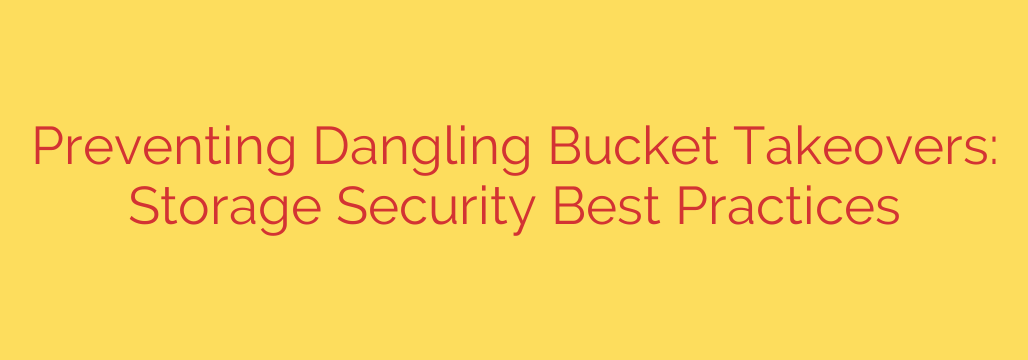
Protect Your Cloud Storage: A Guide to Preventing Dangling Bucket Takeovers
Cloud storage is a cornerstone of modern digital infrastructure, offering unparalleled scalability and flexibility for everything from website assets to application data. However, with this convenience comes a unique set of security challenges. One of the most subtle yet dangerous threats is the “dangling bucket takeover,” a vulnerability that can allow attackers to serve malicious content from your own trusted domains.
This guide will break down what a dangling bucket takeover is, the significant risks it poses, and most importantly, the actionable steps you can take to protect your organization.
What is a Dangling Bucket Takeover? Understanding the Threat
To understand this attack, you first need to know how cloud storage is often integrated with websites. A common practice is to use a custom subdomain (like assets.yourcompany.com) to serve files from a cloud storage bucket. This is done by creating a CNAME record in your DNS settings, which points the subdomain to the cloud provider’s bucket URL (e.g., yourcompany-assets.s3.amazonaws.com).
A dangling bucket takeover occurs in a simple, two-step process:
- The “Dangle”: An administrator deletes a cloud storage bucket (
yourcompany-assets) but forgets to delete the corresponding CNAME record (assets.yourcompany.com) that points to it. The DNS record is now “dangling”—it points to a resource that no longer exists. - The “Takeover”: Since most cloud storage bucket names must be globally unique, an attacker can now create a new bucket in their own cloud account using the exact same name (
yourcompany-assets).
The moment the attacker creates their bucket, your DNS record (assets.yourcompany.com) immediately starts pointing to their malicious content. Your users, and their browsers, have no way of knowing the content they are receiving is not from you.
The High Stakes: What’s at Risk with a Bucket Takeover?
The consequences of a successful dangling bucket takeover can be severe, as it leverages the trust associated with your domain.
- Malicious Content and Malware Distribution: Attackers can host and serve malicious JavaScript, viruses, or other malware directly from your subdomain. This can compromise your users’ machines and lead to widespread infection.
- Targeted Phishing Attacks: The attacker can create a perfect replica of your website’s login page on the compromised subdomain. Users who visit this page will be tricked into entering their credentials, which are sent directly to the attacker.
- Session Hijacking and Data Theft: By injecting malicious scripts (Cross-Site Scripting or XSS), attackers can steal user session cookies, personal information, or financial data entered on your site.
- Severe Brand and Reputation Damage: Having your domain associated with phishing or malware erodes customer trust, which can be incredibly difficult to rebuild. It can also lead to your domain being blacklisted by security vendors and search engines.
Your Defense Plan: Best Practices for Preventing Dangling Bucket Takeovers
The good news is that this vulnerability is entirely preventable with proper operational hygiene and proactive security measures. Here are the essential best practices to implement.
1. Implement a Rigorous Decommissioning Process
This is the single most important step. Your infrastructure off-boarding process must be as disciplined as your onboarding process.
- Create a Checklist: Whenever a cloud resource like a storage bucket is scheduled for deletion, ensure your standard operating procedure (SOP) includes a mandatory step to delete any and all DNS records pointing to it.
- Order of Operations: Always delete the DNS CNAME record before you delete the cloud storage bucket. This ensures there is no window of opportunity for an attacker to perform a takeover.
2. Conduct Regular Audits of DNS and Cloud Resources
You can’t protect what you don’t know you have. Regular audits are crucial for discovering misconfigurations before an attacker does.
- Automate Your Scans: Use automated scripts or security tools to periodically scan all DNS records within your domains.
- Cross-Reference Your Assets: Compare the list of subdomains pointing to cloud storage providers (like
s3.amazonaws.comorstorage.googleapis.com) against your list of currently active storage buckets. Any DNS record that points to a bucket you don’t own or recognize is a critical vulnerability that must be remediated immediately.
3. Enforce Strict Ownership and Naming Conventions
While not a complete solution on its own, thoughtful naming can add a layer of difficulty for opportunistic attackers.
- Unique and Non-Obvious Names: Avoid easily guessable bucket names like
assets-yourcompany. Instead, consider a convention that includes a unique, non-public identifier. - Tag Everything: Use resource tags within your cloud provider to clearly label bucket owners, the associated project, and its purpose. This makes auditing easier and clarifies responsibility.
4. Implement Monitoring and Alerting
Proactive detection can be your last line of defense if a misconfiguration slips through the cracks.
- DNS Monitoring: Set up alerts for any changes to your critical DNS records. Unauthorized changes could be a sign of a compromise.
- Utilize Subdomain Takeover Tools: There are numerous open-source and commercial tools designed specifically to scan for dangling DNS records vulnerable to takeover. Integrate these into your regular security scanning cadence.
Strengthening Your Cloud Security Posture
A dangling bucket takeover is a classic example of how a simple oversight in infrastructure management can create a major security flaw. By treating DNS records with the same level of security as the resources they point to, you can effectively eliminate this threat.
Ultimately, robust security relies on disciplined processes and continuous vigilance. By implementing rigorous decommissioning procedures, performing regular audits, and actively monitoring your digital footprint, you can ensure your cloud storage remains a secure and reliable asset for your business.
Source: https://cloud.google.com/blog/products/identity-security/best-practices-to-prevent-dangling-bucket-takeovers/








